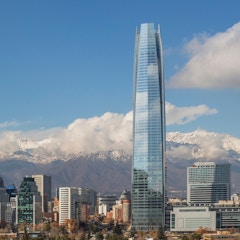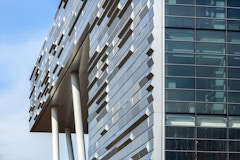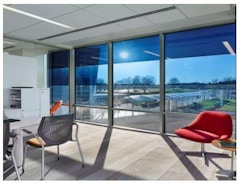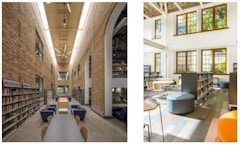
465 results
-

-

Facade Tectonics Forum: CHICAGO
- Event by Facade Tectonics Institute
More details will be announced soon. Make sure you're signed up to receive event updates.
-

Reflections on Views
- Article by Lisa Heschong
Lisa Heschong, a keynote speaker at the Facade Tectonics Institute’s World Congress in October, is a strong proponent for the importance of daylighting and views in all types of buildings, including this excerpt from her recent book, Visual Design in Architecture: Daylight, Vision, and View.
-

Sculptural Facades
- Paper by Matthew A. Trimble · Matthew Culver
In the vein of mass production, manufacturers leverage repeatable parts and modular construction in an effort to maximize quality control while
-

Introducing FacadeRetrofit.org
- Announcement
FacadeRetrofit.org is an online resource for the AEC community, from architects to academic researchers. At the heart of this resource is a database of large commercial and multifamily buildings that have, or are currently undergoing, building facade retrofits.
-

ACT Facade
- Paper by Paul-Rouven Denz · Daniel Arztmann · Natchai Suwannapruk
Due to material and technological advancement during the last century, transparency has become a prominent trend in contemporary architecture.
-

The Versatile Envelope Garden
- Paper by Nathaniel Barlam · Yunyao Lin · Ben Silverman
Facades play an integral role in defining the experience of modern life. As rising populations gravitate from rural to urban communities, they bring
-
Thermal Comfort Assessment of Multi-Zone Electrochromic Window
- Paper by Ahoo Malekafzali, Ph.D.
Access to natural daylight and connection to the outdoor environment is one of the key elements of contemporary architecture. This design concept is
-

Call for Papers: Facade Tectonics 2020 World Congress
- Announcement
We are at a critical moment in the evolution of the built environment. In the face of multiple challenges confronting civilization, the transition to sustainable buildings and urban habitat is happening far too slowly and inefficiently. Central to achieving this transition is the facade system
-

AIA Conference on Architecture 2021
- Event by AIA
A’21 brings together leaders in architecture and beyond for a four-day, immersive digital experience that defines the year ahead. It’s the architecture and design event of the year!
-

Event Passed
The ABCs of ZNE
The journey to a zero net energy (ZNE) future starts with renovating the current paradigm of building design. The way buildings are designed today needs a retrofit in thinking so new projects meet the challenges of the global climate crisis.
Industry Event by Verdical Group
-

Event Passed
The ABCs of ZNE
The journey to a zero net energy (ZNE) future starts with renovating the current paradigm of building design. The way buildings are designed today needs a retrofit in thinking so new projects meet the challenges of the global climate crisis.
Industry Event by Verdical Group
-

Event Passed
The ABCs of ZNE
The journey to a zero net energy (ZNE) future starts with renovating the current paradigm of building design. The way buildings are designed today needs a retrofit in thinking so new projects meet the challenges of the global climate crisis.
Industry Event by Verdical Group
-

Event Passed
The ABCs of ZNE
The journey to a zero net energy (ZNE) future starts with renovating the current paradigm of building design. The way buildings are designed today needs a retrofit in thinking so new projects meet the challenges of the global climate crisis.
Industry Event by Verdical Group
-

Event Passed
The ABCs of ZNE
The journey to a zero net energy (ZNE) future starts with renovating the current paradigm of building design. The way buildings are designed today needs a retrofit in thinking so new projects meet the challenges of the global climate crisis.
Industry Event by Verdical Group
-

Event Passed
The ABCs of ZNE
The journey to a zero net energy (ZNE) future starts with renovating the current paradigm of building design. The way buildings are designed today needs a retrofit in thinking so new projects meet the challenges of the global climate crisis.
Industry Event by Verdical Group
-
Daylighting Parametric Workflows Used for Adaptive Reuse
- Paper by Alfonso E. Hernandez, AIA, NCARB, LEED BD+C
Daylighting & Solar Glare control, which affect both the energy consumption of the building as well as the comfort of the occupants, become
-

Episode 08: Reglazing Modernism
- Podcast by Uta Pottgiesser · Angel Ayón
Special guests Uta Pottgiesser of TU Delft and Angel Ayón of AYON Studio Architecture and Preservation discuss their recent book, Reglazing Modernism, where they explore facade intervention strategies on Modern-era buildings through international case studies.
-

Fire Safety and Code Challenges for Mass Timber in Curtain Wall Systems
- Paper by David Barber, Principal John Neary, Senior Associate, Senior Facade Specialist Mic Patterson PhD LEED AP+, Ambassador of Innovation & Collaboration
With the desire for more sustainable construction and reduced embodied energy, mass timber is being explored for building structures. For medium and… -

Renewing Historic Facades
- Paper by Christine Reynolds, PE · Hans Thummel, AIA, LEED AP BD+C
As the first phase of a $4 billion dollar, 180-acre, 60 building government preservation project in Washington DC, this case study reviews the

